Once the domain of the diamond industry, ore-sorting technology has become much more sophisticated in recent years. E&MJ looks at some of the systems now available, together with analyzers that are bringing real-time capabilities to exploration.
 Eriez supplied this rare-earth roll separator to a silica sand producer in Morocco to remove iron contamination.
Eriez supplied this rare-earth roll separator to a silica sand producer in Morocco to remove iron contamination.Ore sorting has been an essential part of the upgrading process since time immemorial. Bronze Age miners would certainly have been highly selective in their approach to copper ores, using mineral color to choose between good material and waste. Handsorting was a feature of most base- and precious-metal mining well into the 20th century, while historical images of children employed to sort stone from coal are a pointed reminder of past practices and working conditions. In each case, the aim was to remove waste before time and money were spent on upgrading the valuable component.
Fast forward to the present day, and the need is just the same. Putting waste rock through a concentrator is a costly exercise, not only because of the increased throughput, but also in terms of the potential for value losses into tailings streams. Indeed, there seems to have been a resurgence in interest in sorting as a means of both pre-concentrating ore and improving the final quality of concentrates, with the aim of rejecting waste before money is spent on treating it for no return.
The difference, of course, is in the approach. Human eyes and hands have been augmented or replaced by a range of technologies, offering sorting capabilities based on shape, density, color, X-ray fluorescence, radioactive response and a number of other parameters. Technologies developed for other industries, such as scrap metal and plastics recycling, have found new applications in mineral processing, providing the potential for producers to improve their output quality and benefit from better prices for their commodities.
To the general public, diamond sorting has probably been the best-known application, using X-ray fluorescence (XRF) to identify and separate diamonds from a falling material stream. While the mystique and security issues integral to diamond production have made this the case, in practice sorting technology has the potential for much wider application. Having recognized this, a number of specialist manufacturers have developed sorting systems to handle a range of minerals, using physical—and, in some cases, chemical—parameters, either singly or in combination as circumstances require.
Looking Back
In a paper published in a 1974 edition of the Journal of the South African Institution of Mining and Metallurgy, and by the Society of Mining, Metallurgy and Exploration (S.M.E.) in the U.S., Keys, Gordon and Peverett provided an historical perspective of the development of one of the earliest of the modern ore-sorting systems. “This paper,” they said, “concerns the development and application of a high-throughput, multistream photometric sorting machine developed for the South African gold mines. It is now believed that this sorter and its progeny may be found suitable for a large proportion of all possible sorting applications.”
The authors described the work undertaken by ore sorters, then part of the RTZ group, to develop an optical sorting system for Gold Fields of South Africa. The aim was to upgrade run-of-mine ore by segregating reef material from barren waste, with the mechanism relying on the difference in color between the two streams. Acceptable material, the reef, contained white or grey quartz pebbles in a darker surrounding matrix, while the “reject” rocks were greenish to black quartzite and tuff.
Scanning using a laser was undertaken on a belt conveyor, with the load widely distributed so that rocks were not touching. Separation was achieved by air-blasts once the rocks fell from the end of the belt. The first industrial-scale machines, installed at the Doornfontein mine in 1972, each achieved typical throughputs ranging from 50 metric tons per hour (mt/h) for 30-60 mm feed to 200 mt/h for 70-150 mm material.
In its original application, the sorters were used as a back-up to a manual reef-picking plant, handling a specific size fraction from the reject stream that was known to carry nearly half of the gold that had been “thrown away” at that stage. During its first year of operation, it recovered 10,450 oz of gold, then worth some $1.6 million, providing a very positive addition to the mine’s cashflow, the authors stated. “Clearly,” they said, “the possibilities of photometric sorting are inviting.”
The State of the Art
In a paper presented at the European Mineral Resource Conference in Leoben, Austria, in 2012, Dr. Hermann Wotruba from RWTH Aachen University provided an overview of the current state of the art in relation to sorting systems. He pointed out that while sensor-based sorting is used at all modern facilities to process materials such as glass, plastics, paper and cardboard, and the number of machines in operation is increasing, this type of technology is still only rarely used for mineral raw materials. Exceptions, he said, include minerals such as calcite and diamonds.
However, he added, “plant operators and planners are only slowly beginning to appreciate the potential of this technology and it is to be expected that its use will increase noticeably in the future.”
According to Wotruba, the sensor-based sorting process comprises four sub-processes, each of which influences the effectiveness of the process as a whole.
These are:
- Material conditioning;
- Feed and isolation;
- Detection and evaluation; then
- Mechanical ejection.
Material conditioning ensures that the material to be separated is fed to the actual sorter in suitable particle sizes and in a suitable condition, he explained, adding that the technique can currently be used to sort particles in a size range of 1 mm to 300 mm. Tight sizing is critical to the success of the operation, since having too wide a range of particle sizes passing through a sorter makes its task much harder. And, Wotruba pointed out, the flow rates that would be needed by large iron-ore or copper mines can currently only be achieved by using a number of sorters operating in parallel.
The feeding and isolation step involves creating a single particle-depth layer across the feed belt, giving the sorter the best chance of identifying individual particles accurately. The sensors themselves can be based on a number of physical or chemical parameters, with the current armory including:
- Optical sensors;
- Near infrared spectroscopy (NIR);
- X-ray transmission (XRT);
- Inductive sensors;
- X-ray fluorescence (XRF) with a photomultiplier (for diamonds);
- X-ray fluorescence for elemental analysis; and
- Radiometric sensors.
Until recently, Wotruba said, all sensor-based sorting was carried out using recognition or measuring techniques for “secondary” or non-specific material properties, such as color. This is changing as sensor technology becomes more sophisticated.
Examples of minerals that can be detected using optical sensors with RGB line-scan cameras include a range of industrial minerals, gemstones such as diamonds, emeralds and tanzanite, and chrome, gold, nickel, platinum and oxidized copper ores. XRT sensors find applications in sorting scheelite, wolframite, coal, diamonds and iron ore, while inductive sensors can be used to identify sulphide ores.
Minerals that have the potential for identification using XRF for elemental analysis include nickel, copper and zinc sulphides, gold and platinum, chromite, manganese, uranium, and bauxite, while radiometric sensors clearly have uses in sorting uranium ores. Other, more technologically advanced sensors are under development, Wotruba said.
Finally, the ejection stage involves the use of air or water pulse jets or mechanical devices to separate the wanted particles from the discard.
Where to Sort?
Probably the most significant use of sorters is to remove waste rock, and hence up- grade the feed for a subsequent stage of processing. This can be used on both fresh ore and on tailings that are being re- processed, where the in-situ grade is likely to be low in any case. Then there is the potential to separate out high- and low-grade streams for different processing routes, based perhaps on differing mineralogy or on the presence of contaminants.
There is also the possibility of sorting underground, before waste rock is transported to surface and then has to be stored above ground. Benefits here include reductions in the tonnage transported and in the tailings capacity needed. In a paper presented at this year’s Sensor-Based Sorting conference, held March 11-13 at Aachen, Germany, Christian Schropp and some colleagues from the Mineral Processing department at RWTH Aachen looked at the potential for near-face sorting underground.
The authors’ work is a contribution to the European-wide project aimed at developing technologies to reduce mining’s footprint—the so-called “invisible mine.” The need to enhance grades becomes greater, they said, as mine depths increase, since energy costs for transport underground and hoisting start to rise exponentially at depths below 1,500 m.
They also make a distinction between operations that have concentrating facilities installed underground—such as Andina in Chile and that proposed for Noront Resources’ Eagle’s Nest project in Ontario’s Ring of Fire—and the use of near-face semi-mobile sorting plants to remove waste as close as possible to the production and final storage point.
The capability to achieve high throughput is essential, they point out, so as to avoid creating a bottleneck early in the processing system. Dry sorting is preferable, while throughput rates of around 300 mt per meter of sorter width should be achievable when handling coarse run-of-mine rock in the size range 20-300 mm. Clearly, given that having a tighter control on the size distribution passing through a sorter is better, the inference is that such a system would not be as precise as one operating with a sized feed.
RWTH Aachen has been cooperating with the specialist sorting equipment manufacturer, Tomra Sorting, to design such a machine. The concept described by Schropp and his colleagues consists of a chain conveyor feeding crushers to reduce the feed to manageable sizes, followed by screens, the sorter itself and, if needed, a de-dusting unit at the end. The entire system has been designed to fit into standard shipping containers, and is 63-m long, 5-m wide and a maximum 6.5-m high if equipped with the de-dusting unit.
Applying the concept to a room-and-pillar potash operation, a combination of optical, NIR and XRT sensors could be used to separate waste from ore, with the system screening out and bypassing -20 mm material. Coarse waste rejected by the sorters would then be stored back in mined-out rooms, while only the reduced volume of enhanced-grade ore would need to be transported to surface.
Tomra’s Sorters Pre-concentrate Tungsten
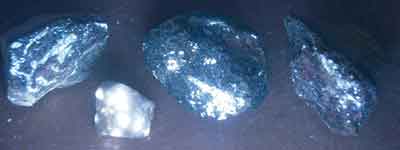 Tungsten particles upgraded in a Tomra sorter.
Tungsten particles upgraded in a Tomra sorter.At the beginning of last year, Germany’s Tomra Sorting merged with its sister company, CommodasUltrasort. The company claims there are now more than 200 of its systems in operation worldwide, used for pre-concentrating. It also claims that its sensor-based sorters can reduce a mining operation’s energy consumption by 15%, as well as cut water usage.
The detection technologies used in its systems include color recognition, NIR, XRF, XRT, electromagnetic, visual spectrometry and photometric. Its main system with minerals-sector applications, PRO, is based on the free-fall or chute principle, leading to a very simple and compact design, Tomra said. Particle size ranges between 2 mm and 300 mm are covered by three models that are typically fitted with color, XRT or NIR scanners.
Tomra noted that for a gold waste-dump application, a head grade of at least 0.4 g/mt is required to make sorting economically viable. However, as well as selecting ore, its system can also remove pyrite-bearing waste, which can reduce the potential for acid formation once the waste has been re-stacked. For copper, its sensors can detect both sulphide and oxide ores, and can handle flow rates of up to 300 mt/h, while other metals for which they are suitable include tungsten, silver, nickel and platinum-group metals. In addition, the company highlights the potential for recovering metals from furnace slags, either as a secondary resource or to remove a potential contamination source.
Tomra cited the use of its XRF sorters at the Austrian scheelite producer, Wolfram Bergbau und Hütten. Formerly, the operation’s entire output of 500,000 mt/y of run-of-mine ore was processed; following the introduction of sorting, between 80,000 mt/y and 120,000 mt/y of waste are rejected ahead of the concentrator, the head grade is higher, and the company saves on energy, chemicals and tailings disposal costs.
Stripping Out Sulphur
According to its managing director, Jacek Kolacz, the Norwegian company Comex has developed a new sensor-based sorting system related to complex image analysis. This, he said in his paper to the Sensor-Based Sorting conference in Aachen, makes it possible to separate different mineral particles in relation to their color, shape, texture, size and density, and indirectly to their composition. Kolacz reported that the sorting system has been successfully tested and applied for sorting minerals, and had achieved separation efficiencies of 95%–99.9%. The main advantage of this system, he said, is that a number of material parameters are analyzed in the same processing unit during a single pass though the system.
Kolacz stated that sensor-based sorting must always be tailored for particular applications, and that very few of the systems available on the market today are flexible enough to be applied in very different conditions without complicated reprogramming and reconstruction. Because of this, the complexity of sorting makes such applications cost-prohibitive or significantly reduces its potential.
The main limitations of current systems, he added, include their inability to process both large and small particles at the same time, their limited analysis complexity, and inaccurate rejection. This has led to the majority of systems being color recognition-based, and achieving relatively poor (85%–95%) separation efficiencies.
The new Comex system incorporates both color and XRT sensors that can be used either in combination or individually. Integrating the data from XRT with that from optical scanning provides a lot more information about the particle surface properties and its internal structure, Kolacz said. “All these sophisticated analyzing functions require a lot of computation power and they have to be optimized to allow high capacity sorting,” he said. “This is done by special program architecture and algorithm solutions, allowing efficient management of the calculation routines and sorting priorities.”
For example, optical scanning can be used as a pre-filter for X-ray scanning, effectively reducing the volume to be handled by the sensor that requires greater computation analysis power. An alternative would be to use the sensors in reverse order, or together, the sequence depending on the parameters of the minerals being sorted.
Kolacz provided the example of work that Comex has done on upgrading an iron ore that was too low-grade and impure to be marketable. A first XRT sensor was used to reject low-iron-content material as waste, a second to identify pyrite inclusions, with a third, optical stage to complete the pyrite-removal process. At each stage, the waste already identified was masked from the next scanner, with all of the waste being separated out as the final part of the process. Doing this enhanced a feed containing 56% Fe and 0.15% S to a plus-62% Fe, 0.04% S direct-shipping material.
X-rays See Through the Rock
According to the German company, Steinert Elektromagnetbau, two products from its extensive separation-equipment range—the XSS X-ray sorter and the ISS induction sorter—find applications in the minerals sector as well as in recycling. Using XRT technology, the XSS “sees” through the material on the screening belt, recognizing particles with different densities and allowing minerals to be sorted from waste. With an XRF scanner, the system can be used to differentiate alloys, metals and ores based on their surfaces. Suitable materials for sorting using the XSS include ores and coal.
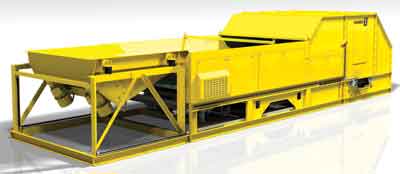
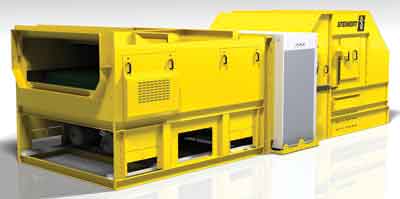 Steinert’s ISS (top) and XSS (bottom) use magnetic induction and XRF sorting technologies.
Steinert’s ISS (top) and XSS (bottom) use magnetic induction and XRF sorting technologies.Meanwhile, the ISS can be used to sort metals that cannot be recovered using magnetic or other separation processes. The system uses magnetic induction to identify metallic particles, which can then be removed from the material stream using pulsed air jets.
As the company’s name suggests, it has long-standing experience with magnetic separators. For example, its HGS high-gradient magnetic separator consists of a short conveyor belt equipped with a permanent magnet disc system in its head drum. Powerful neodymium-iron-boron magnets allow it to separate even weakly magnetic mineral components, Steinert said. The company also uses this type of magnet in its new generation of wet-drum separators, used for separating heavy media and ore particles from wet slurries.
In this year’s Best of Germany special supplement to the January edition of E&MJ, Steinert reported on an application of its X-ray sorter technology at the Wolfram Camp tungsten-moly-bismuth mine in Australia. With earlier testwork having indicated that this approach could be used to remove a considerable proportion of waste from the run-of-mine ore, the company commissioned an X-ray sorter there last year—enabling the operator effectively to double its plant capacity.
Eriez: Focusing on Magnets
According to Paul Fears, sales director for Eriez Magnetics Europe, environment pressures are forcing mineral processors to review their process methods, waste handling and resources. Companies are evaluating and using “clean” processing techniques to replace traditional methods where chemicals are required and chemical waste is produced. The cost savings from reducing chemical waste are significant, he said, with high-intensity magnetic separation being used or under evaluation as an environmentally friendly technique of processing non-metallic minerals.
The technology encompasses the rare-earth roll separator for dry processing, and the high-intensity magnetic filter and superconducting Powerflux for wet processing.
The company reported that controlled testwork on materials including feldspar, sand, and kaolin has proved that magnetic separation can be used to eliminate entirely or partially the need for systems such as flotation, to liberate good product from waste, and can open the way for processing lower-grade materials to extend the life of a deposit.
Eriez claims that its Powerflux superconducting magnet is the only one currently available that operates without cryogenic cooling, thereby cutting production costs. The company cited the case of its use at a kaolin operation in the U.K., where it is used to remove various forms of iron contamination from the clay. The technology has allowed the operator to upgrade lower-quality kaolin, reduce the amount of waste for long-term storage, and offer a wider range of products. In addition, the operation has increased its reserve base ten-fold, Eriez said.
The company suggested that in some applications, magnetic separators can offer a viable alternative to flotation. These include specialist operations such as purifying silica sand for the glass industry and processing feldspar for the ceramics and glass industries. Here, high-intensity filters are being used to reduce contamination from iron and minerals such as chromite and ilmenite, giving a higher-specification—and hence higher-value—product.
Real-time Analysis Aids Exploration
The time-lag between samples being taken and results returning from the analysis laboratory is one of the bugbears that has traditionally hindered mineral exploration. Having been collected and prepared, samples take time to process, with accuracy all-important.
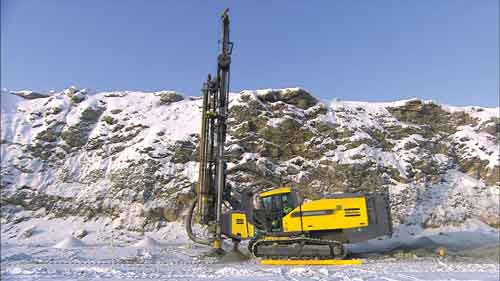 Made by the Finnish company, IMA Engineering, the OREalyzer analyzes rock-chip samples during drilling, sending real-time data to the mine office.
Made by the Finnish company, IMA Engineering, the OREalyzer analyzes rock-chip samples during drilling, sending real-time data to the mine office.Real-time data are no longer just a pipe dream, however. As noted in the Nordic mining equipment review in the October 2013 edition of E&MJ (Nordic Mining 2013), the Finnish company IMA Engineering now produces a fully automated drill-cutting sampler and analyzer. Marketed by Atlas Copco as the OREalyzer, the unit provides real-time analysis information from the cuttings produced by blast-hole or reverse-circulation drill rigs, with the data being transmitted to a mine’s grade-control center for the production of updated mining plans.
The company also offers loader-bucket analyzers that can be used to differentiate between ore and waste at the loading point on a bucket-by-bucket basis. This allows waste to be rejected at an early stage in the transport process, thereby saving costs.
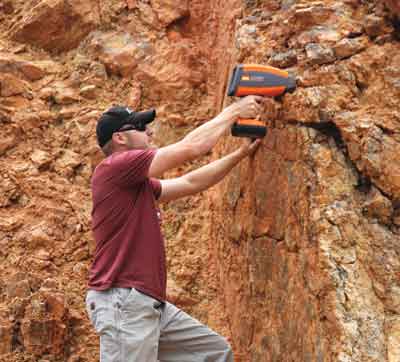 Site analysis using PANalytic’s TerraSpec Halo.
Site analysis using PANalytic’s TerraSpec Halo.Hand-held analyzers are also becoming more widely used, especially for exploration. For instance, PANalytical Boulder recently introduced the ASD TerraSpec Halo mineral identifier, a hand-held, full-range NIR spectrometer. In addition to providing field geologists with real-time information and quicker delineation of alteration halos or clay species, the device can be used in the core shack or on the rig for faster core and drill-chip analysis, the company said.
“The ASD TerraSpec Halo mineral identifier brings needed efficiency to the field by removing weight and complexity to give real-time mineral information,” said Chris Sherry, the company’s senior market manager.
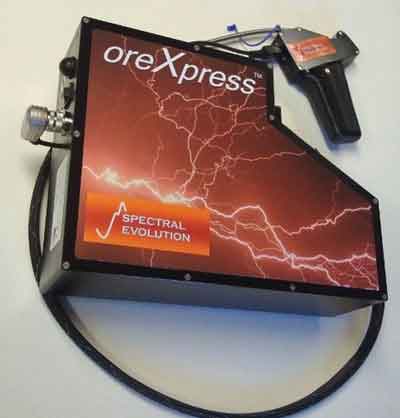 The oreXpress portable spectrometer.
The oreXpress portable spectrometer.Another recent introduction, the Spectral Evolution mineral contact probe, is designed for mining exploration, core-shack logging and chip-tray analysis. Described as lightweight and comfortable, the probe measures surface reflectance from 350 nm to 2,500 nm, and plugs directly into the company’s oreXpress, oreXpress platinum or other spectrometers or spectroradiometers.
The man-portable oreXpress works with EZ-ID real-time mineral identification software and the USGS and SpecMIN libraries for field analysis and identification, the company added. With EZ-ID, a geologist can use electable match regions for the identification of multiple minerals in mixtures, while SpecMIN includes an extensive library of nearly 500 infrared-active mineral species. The company said that EZ-ID software can be used for real-time mineral identification at outcrops and with hand samples, and is especially useful in fast and accurate core-logging applications.
The technology involved in both ore sorting and mineral analysis has made huge leaps forward in recent years, in terms of capabilities, speed and reliability. Real-time analysis is fast becoming a realistic tool for the exploration geologist, helping to save time and improve exploration focus.
Ore sorting is still a niche application, albeit one that is gaining in interest as more and more mineral producers realize the benefits that can be won from rejecting waste rock before spending money on processing it. A whole raft of different physical and chemical properties can be used to achieve separation, either singly or in combination, and the application of much greater computing power had meant that system accuracy is now better than ever before.









